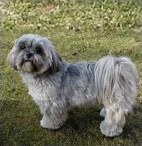 Lhasa Apsos – Critical Facts Tips And Information You Need To Know
Lhasa Apsos – Critical Facts Tips And Information You Need To Know
The Lhasa Apso takes its name from Tibet’s capital (Lhasa) and the Tibetan word “apso,” which means “bearded.” This breed was first used as the watchdogs of Tibetan monks, and is now considered as a non-sporting dog breed. Lhasa Apsos are quite popular among Hollywood celebrities; Bethenny Frankel and Gwen Stefani are two famous people who own an Lhasa Apso.
Description and General Appearance
The Lhasa Apso has long straight fur, and his coat can either be gold, black, and white or a combination of the three. Lhasa Apso puppies often change the color of their coats as they grow older. This dog has dark brown eyes and a feathery tail that is carried over his back. The Lhasa Apso also has a lot of fur on his hind legs and feet.
Basic Temperament
This breed has a friendly and affectionate temperament and is very intelligent. However, Lhasa Apsos are prone to several negative behaviors, such as Small Dog Syndrome, separation anxiety, and guarding behaviors. Owners can prevent these from forming through proper training and socialization, and by imposing certain rules that the dogs have to follow.
Care Required
Knowing how to take care of an Lhasa Apso is important, because this determines what kind of dog it will grow up to be. This breed needs to be given three things to become a loving, well-behaved, and affectionate dog: proper grooming, a healthy diet, and obedience training. They require daily brushing and frequent bathing, but most owners prefer to have their dog’s fur trimmed to prevent it from tangling. Lhasa Apsos only need to eat once or twice every day; owners can ask their veterinarian or breeder about the right type of dog food to give them. Obedience training helps the dog grow to be friendly and well-mannered.
Exercise Requirements
This dog needs daily exercise, such as a routine walk with his owners around the neighborhood. They also like to play with their family members, and owners who have large backyards can let their Lhasa Apso run off leash to let him work off most of his pent-up energy.
Training Tips
Lhasa Apso training is crucial if one wants to have a well-behaved dog. Owners need to establish their status as the leader of the family if they want their dogs to follow them. They can use the crate method to start housebreaking their dog, and use treats when teaching him to obey. When socializing an Lhasa Apso, owners need to make sure that it only meets one person at a time, otherwise it might become overwhelmed.
Height and Weight
The Lhasa Apso only grows to be 25 to 28 centimeters tall, and can weigh from 5.9 to 6.8 kilograms.
Health and Longevity
The Lhasa Apso can live up to 18 years and is generally a very healthy breed. There are only a few health problems that are associated with this breed, but owners also have to protect their dog from getting bleeding ulcers, hip dysplasia, and skin problems. Owners should always bring their dog to a veterinarian for regular check-ups and vaccination shots, which would let them identify any diseases early on.
Suitability As a Pet
Lhasa Apsos make very good watchdogs, and they bark loudly whenever they see a stranger or hear an unfamiliar noise. This breed is not ideal for first-time dog owners, because these dogs need regular grooming, early socialization, and proper obedience training. However those who take good care of their pet will find that the Lhasa Apsois a fun-loving, active, and easy-going dog.
For more information about the Lhasa Apsos, check out the highly recommended Insiders Guide To A Happy, Healthy & Well Behaved Lhasa Apsos package today!
Other Informative Articles:
• SAVE 42% off the normal price of DIY Dog Training for Lhasa Apsos
• Best Flea Treatment for Lhasa Apso and Other Long-Haired Dogs
• Lhasa Apso Puppies—What To Consider When Buying A New Apso Puppy
• Tear Stains and Treatment in Lhasa Apsos and Other Long-Coat Breeds
They contain some great Lhasa Apsos information.
All the best.


